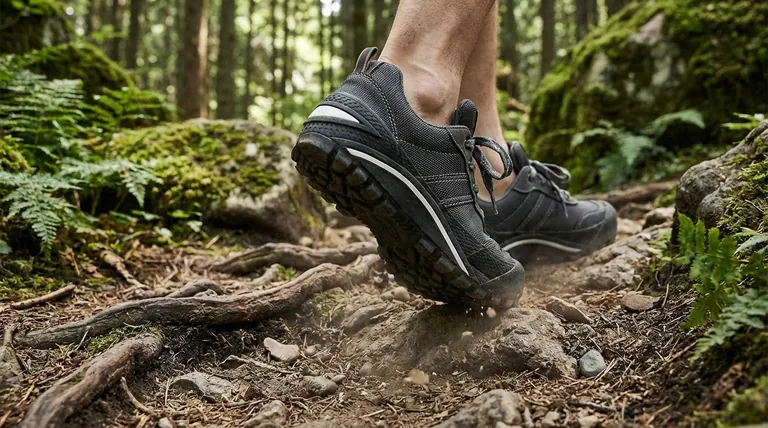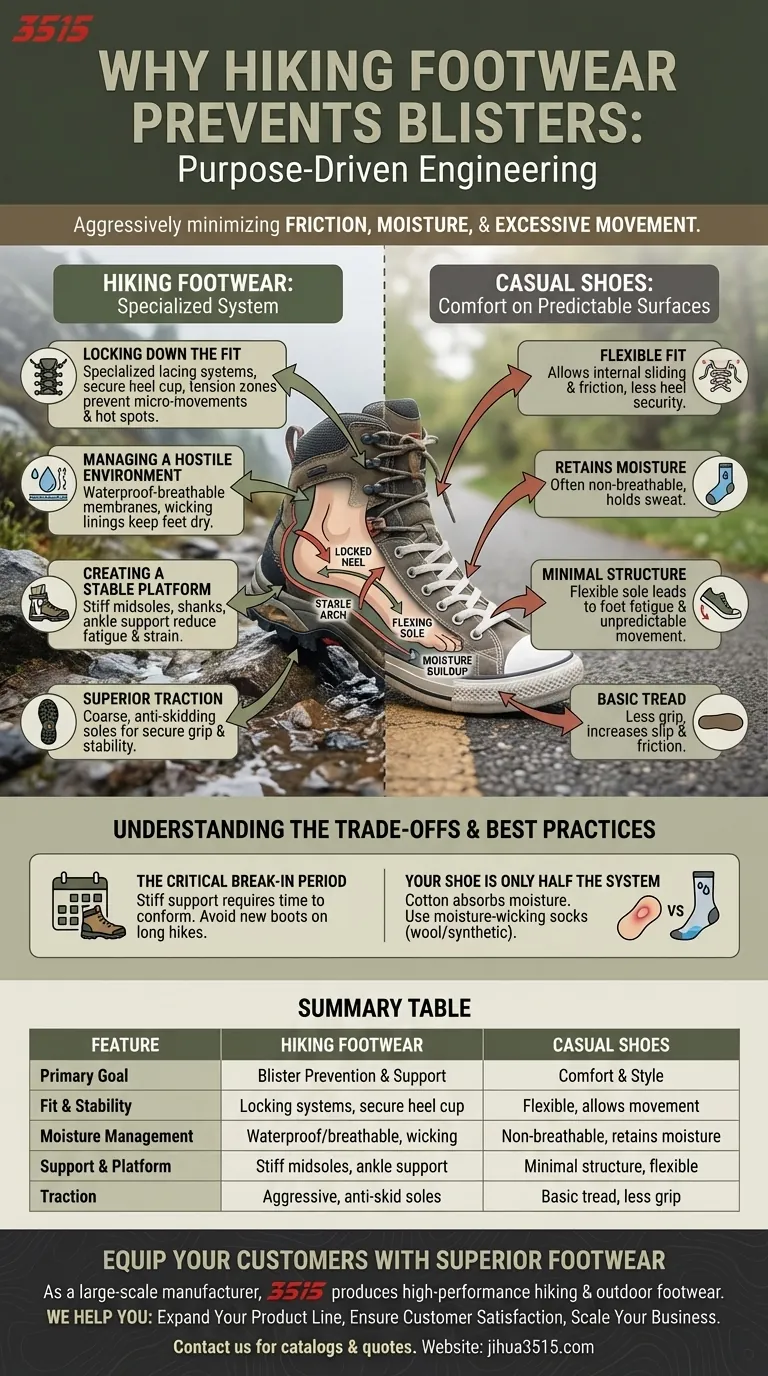At its core, the difference is purpose-driven engineering. Hiking footwear is a specialized system designed to prevent blisters by aggressively minimizing its three root causes: friction, moisture, and excessive movement. Unlike casual shoes built for comfort on predictable surfaces, every component of a hiking boot or shoe is designed to create a stable, dry, and secure environment for your foot under demanding conditions.
A blister is a direct symptom of friction against the skin. Hiking footwear systematically eliminates this friction by locking your foot onto a stable platform, managing moisture, and preventing the internal sliding that casual shoes permit.

The Anatomy of Blister Prevention
A casual sneaker and a hiking boot may look superficially similar, but their internal architecture is fundamentally different. The features that make a hiking boot feel stiff or heavy are the very same features that protect your feet over long distances.
Locking Down the Fit
The single biggest cause of blisters is your foot sliding inside your shoe, particularly at the heel. Hiking footwear directly counters this.
Specialized lacing systems, often with locking eyelets, allow you to create different tension zones. This lets you secure your heel firmly in the boot’s heel cup while allowing more room for your toes.
This precise fit adaptation prevents the micro-movements—the rubbing with every single step—that wear down skin and create hot spots.
Managing a Hostile Environment
Your feet sweat, and trails can be wet. Moisture softens the skin, making it dramatically more susceptible to damage from friction.
Hiking footwear incorporates water-resistant or waterproof-breathable membranes. These materials keep external water out while allowing sweat vapor to escape, helping to keep your feet drier.
The thicker lining and materials are also designed to wick moisture away from your skin, working in concert with proper hiking socks to maintain a healthier environment for your feet.
Creating a Stable Platform
A casual shoe is flexible, allowing your foot to bend and adapt. On uneven terrain, this flexibility becomes a liability, causing your foot to fatigue and move unpredictably inside the shoe.
Hiking boots provide significantly more arch and foot support through stiffer midsoles and shanks. This structure acts as a stable platform, reducing the strain on the muscles in your feet.
A less-fatigued foot maintains a more consistent and stable stride, which directly translates to less rubbing and a lower chance of blisters. The added ankle support from boots also prevents ankle rolling, which further stabilizes the entire foot.
The Role of Superior Traction
You might not connect the tread on the bottom of a boot with blisters on your heel, but they are directly related.
The coarse, anti-skidding soles on hiking footwear provide a superior grip on rock, dirt, and mud. When your boot is locked to the ground, your foot is less likely to slip within the boot.
Every time your footwear slips on the trail, your foot lurches inside the shoe to compensate. This instability creates friction, and over thousands of steps, that friction builds into a blister.
Understanding the Trade-offs
This specialized protection comes with necessary compromises. Understanding them is key to using the footwear effectively and avoiding common pitfalls.
The Critical Break-In Period
The stiffness that provides support and prevents blisters also means that new hiking boots are not immediately comfortable. They require a break-in period to allow the materials to conform to the unique shape of your foot.
Wearing brand-new, stiff boots on a long hike is a common and painful mistake that can cause the very blisters you're trying to prevent.
Weight and Flexibility
Hiking footwear is heavier and less flexible than a casual shoe. This is a non-negotiable trade-off for durability, support, and protection.
While this added weight may feel cumbersome at first, it is essential for supporting your foot and ankle under the load of a pack and the stress of uneven terrain.
Your Shoe Is Only Half the System
The most advanced hiking boot in the world can be defeated by a poor pair of socks. Cotton socks are a blister's best friend.
Cotton absorbs moisture and holds it against your skin, creating the perfect soft, damp environment for friction to do its damage. Always pair your footwear with moisture-wicking socks made from wool or synthetic materials.
Making the Right Choice for Your Feet
The best footwear is the one that matches the demands of your specific activity.
- If your primary focus is day hiking on maintained trails: A lighter hiking shoe often provides sufficient support and blister prevention without the weight of a full boot.
- If your primary focus is multi-day backpacking with a heavy pack: The superior ankle support and rigid structure of a hiking boot are critical for preventing fatigue and the foot movement that leads to blisters.
- If your primary focus is hiking in wet or unpredictable weather: Prioritize footwear with a reliable waterproof-breathable membrane and pair it with quality moisture-wicking socks.
Choosing the right footwear is the most critical step you can take to ensure your focus remains on the trail ahead, not on the pain in your feet.
Summary Table:
| Feature | Hiking Footwear | Casual Shoes |
|---|---|---|
| Primary Goal | Blister Prevention & Support | Comfort & Style |
| Fit & Stability | Locking lacing systems, secure heel cup | Flexible, allows foot movement |
| Moisture Management | Waterproof/breathable membranes, wicking liners | Often non-breathable, retains moisture |
| Support & Platform | Stiff midsoles, arch support, ankle support | Minimal structure, flexible sole |
| Traction | Aggressive, anti-skid soles for stability | Basic tread, less ground grip |
Ready to Equip Your Customers with Superior Footwear?
As a large-scale manufacturer, 3515 produces a comprehensive range of high-performance hiking and outdoor footwear designed for durability, comfort, and blister prevention. Our production capabilities encompass all types of shoes and boots, perfect for distributors, brand owners, and bulk clients looking to source reliable products.
We help you:
- Expand Your Product Line with technically advanced footwear.
- Ensure Customer Satisfaction with products built for performance and comfort.
- Scale Your Business with our high-volume manufacturing expertise.
Let's discuss your footwear needs. Contact our team today to request a catalog or get a quote!
Visual Guide

Related Products
- Durable Rubber Sole Outdoor Shoes Wholesale & Custom Manufacturing
- Safety Footwear Wholesale Manufacturer for Custom OEM/ODM Production
- Durable Waterproof Rain Boots | Custom Manufacturer for Wholesale & Brands
- Wholesale Safety Footwear Manufacturer for Bulk & Custom OEM Orders
- Wholesale Durable Breathable Safety Boots Custom OEM Manufacturer
People Also Ask
- How do hiking shoes or boots protect feet from environmental hazards? A Guide to Trail-Ready Footwear
- What are the main applications of vulcanized rubber? Unlock Durability for Tires, Footwear & More
- What are some alternatives to hunting boots? Hiking, Rubber & Tactical Boots Explained
- What are the disadvantages of vulcanized soles? Lack of Support & Durability Explained
- How does cushioning work in hiking shoes? The Science of Shock Absorption



















